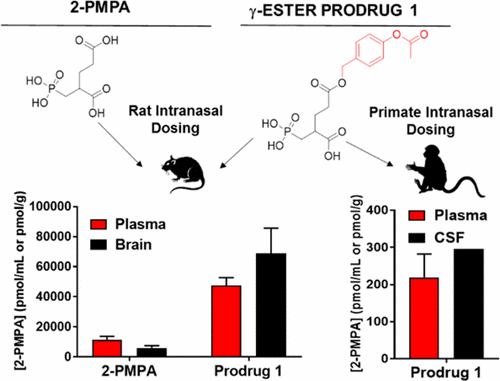当前位置:
X-MOL 学术
›
Mol. Pharmaceutics
›
论文详情
Our official English website, www.x-mol.net, welcomes your
feedback! (Note: you will need to create a separate account there.)
Enhanced Brain Delivery of 2-(Phosphonomethyl)pentanedioic Acid Following Intranasal Administration of Its γ-Substituted Ester Prodrugs
Molecular Pharmaceutics ( IF 4.5 ) Pub Date : 2017-08-31 00:00:00 , DOI: 10.1021/acs.molpharmaceut.7b00231 Michael Nedelcovych , Ranjeet P. Dash , Lukáš Tenora 1 , Sarah C. Zimmermann , Alexandra J. Gadiano , Caroline Garrett , Jesse Alt , Kristen R. Hollinger , Elie Pommier , Andrej Jančařík 1 , Camilo Rojas , Ajit G. Thomas , Ying Wu , Krystyna Wozniak , Pavel Majer 1 , Barbara S. Slusher , Rana Rais
Molecular Pharmaceutics ( IF 4.5 ) Pub Date : 2017-08-31 00:00:00 , DOI: 10.1021/acs.molpharmaceut.7b00231 Michael Nedelcovych , Ranjeet P. Dash , Lukáš Tenora 1 , Sarah C. Zimmermann , Alexandra J. Gadiano , Caroline Garrett , Jesse Alt , Kristen R. Hollinger , Elie Pommier , Andrej Jančařík 1 , Camilo Rojas , Ajit G. Thomas , Ying Wu , Krystyna Wozniak , Pavel Majer 1 , Barbara S. Slusher , Rana Rais
Affiliation

|
2-(Phosphonomethyl)pentanedioic acid (2-PMPA) is a potent and selective inhibitor of glutamate carboxypeptidase-II (GCPII) with efficacy in multiple neurological and psychiatric disease models, but its clinical utility is hampered by low brain penetration due to the inclusion of multiple acidic functionalities. We recently reported an improvement in the brain-to-plasma ratio of 2-PMPA after intranasal (IN) dosing in both rodents and primates. Herein, we describe the synthesis of several 2-PMPA prodrugs with further improved brain delivery of 2-PMPA after IN administration by masking of the γ-carboxylate. When compared to IN 2-PMPA in rats at 1 h post dose, γ-(4-acetoxybenzyl)-2-PMPA (compound 1) resulted in significantly higher 2-PMPA delivery to both plasma (4.1-fold) and brain (11-fold). Subsequent time-dependent evaluation of 1 also showed high brain as well as plasma 2-PMPA exposures with brain-to-plasma ratios of 2.2, 0.48, and 0.26 for olfactory bulb, cortex, and cerebellum, respectively, as well as an improved sciatic nerve to plasma ratio of 0.84. In contrast, IV administration of compound 1 resulted in similar plasma exposure of 2-PMPA versus the IN route (AUCIV: 76 ± 9 h·nmol/mL versus AUCIN: 99 ± 24 h·nmol/mL); but significantly lower nerve and brain tissue exposures with tissue-to-plasma ratios of 0.21, 0.03, 0.04, and 0.04 in nerve, olfactory bulb, cortex, and cerebellum, respectively. In primates, IN administration of 1 more than doubled 2-PMPA concentrations in the cerebrospinal fluid relative to previously reported levels following IN 2-PMPA. The results of these experiments provide a promising strategy for testing GCPII inhibition in neurological and psychiatric disorders.
中文翻译:

经鼻内给药其γ-取代的酯前药后增强的2-(膦酰基甲基)戊二酸的脑传递。
2-(膦酰基甲基)戊二酸(2-PMPA)是有效的和选择性的谷氨酸羧肽酶-II(GCPII)抑制剂,在多种神经系统疾病和精神疾病模型中均有效,但由于其包含在内,其低脑穿透性阻碍了其临床实用性多种酸性功能。我们最近报道了啮齿动物和灵长类动物经鼻内(IN)给药后2-PMPA的脑浆比有所改善。在本文中,我们描述了几种2-PMPA前药的合成,其中IN给药后通过掩盖γ-羧酸盐进一步改善了2-PMPA的脑部递送。与大鼠给药后1小时的IN 2-PMPA相比,γ-(4-乙酰氧基苄基)-2-PMPA(化合物1)导致向血浆(4.1倍)和大脑(11倍)的2-PMPA传递明显更高。随后的时间依赖性评估1还显示,嗅觉球,皮层和小脑的大脑与血浆比率分别为2.2、0.48和0.26的高大脑和血浆2-PMPA暴露,以及坐骨神经痛的改善神经与血浆的比率为0.84。相比之下,化合物1的静脉给药导致2-PMPA的血浆暴露与IN途径相似(AUC IV:76±9 h·nmol / mL相对于AUC IN:99±24 h·nmol / mL); 但神经,嗅球,皮层和小脑的组织与血浆的比率分别为0.21、0.03、0.04和0.04,从而显着降低了神经和脑组织的暴露。在灵长类动物,的IN施用1在脑脊液中相对于先前报道的水平增加了一倍以上2-PMPA浓度以下IN 2-PMPA。这些实验的结果为测试神经和精神疾病中的GCPII抑制提供了一种有希望的策略。
更新日期:2017-08-31
中文翻译:

经鼻内给药其γ-取代的酯前药后增强的2-(膦酰基甲基)戊二酸的脑传递。
2-(膦酰基甲基)戊二酸(2-PMPA)是有效的和选择性的谷氨酸羧肽酶-II(GCPII)抑制剂,在多种神经系统疾病和精神疾病模型中均有效,但由于其包含在内,其低脑穿透性阻碍了其临床实用性多种酸性功能。我们最近报道了啮齿动物和灵长类动物经鼻内(IN)给药后2-PMPA的脑浆比有所改善。在本文中,我们描述了几种2-PMPA前药的合成,其中IN给药后通过掩盖γ-羧酸盐进一步改善了2-PMPA的脑部递送。与大鼠给药后1小时的IN 2-PMPA相比,γ-(4-乙酰氧基苄基)-2-PMPA(化合物1)导致向血浆(4.1倍)和大脑(11倍)的2-PMPA传递明显更高。随后的时间依赖性评估1还显示,嗅觉球,皮层和小脑的大脑与血浆比率分别为2.2、0.48和0.26的高大脑和血浆2-PMPA暴露,以及坐骨神经痛的改善神经与血浆的比率为0.84。相比之下,化合物1的静脉给药导致2-PMPA的血浆暴露与IN途径相似(AUC IV:76±9 h·nmol / mL相对于AUC IN:99±24 h·nmol / mL); 但神经,嗅球,皮层和小脑的组织与血浆的比率分别为0.21、0.03、0.04和0.04,从而显着降低了神经和脑组织的暴露。在灵长类动物,的IN施用1在脑脊液中相对于先前报道的水平增加了一倍以上2-PMPA浓度以下IN 2-PMPA。这些实验的结果为测试神经和精神疾病中的GCPII抑制提供了一种有希望的策略。











































 京公网安备 11010802027423号
京公网安备 11010802027423号